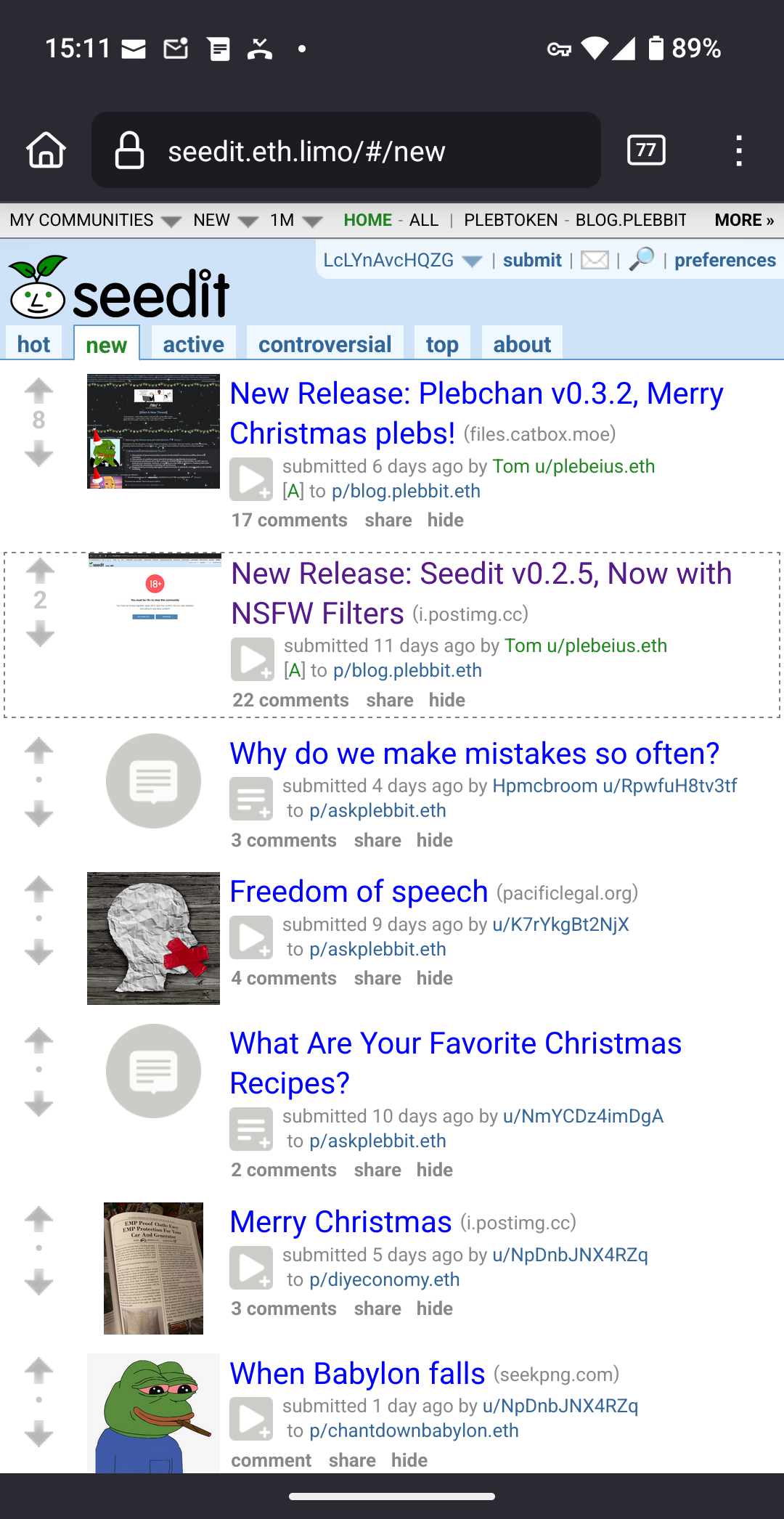Plebbit is a selfhosted, opensource, nonprofit social media protocol, this project was created due to wanting to give control of communication and data back to the people.
Plebbit only hosts text. Images from google and other sites can be linked/embedded in posts. This fixes the issue of hosting any nefarious content.
ENS domain are used to name communities.
Plebbit currently offers different UIs. Old reddit and new reddit, 4chanw, andhave a Blog. Plebbit intend to have an app, internet archive, wiki and twitter and Lemmy. Choice is important. The backend/communities are shared across clients.
From the FAQ linked on the site:
Q: Is this running on ETH? A: the token is on ETH, the plebbit protocol itself it not a blockchain, but the app will use several blockchains, tokens and NFTs to recreate all the features from reddit, like usernames, subplebbit names will be crypto domains like ENS (and other chains), awards will be NFTs, tips and upvotes will earn tokens (can set them to your own token or any coin of your choice in your subplebbit)
[…]
Q: What role does the PLEB token play? A: The base protocol doesn’t use tokens, which lets people who don’t have interest in cryptocurrency (yet) use it for free, but optionally you can use any tokens to do many things, for example you can use names.eth (ENS, which are non fungible tokens) to represent a username or subplebbit name. You can use NFT images as avatars. You can use fungible tokens and NFTs (any token or cryptocurreny of the subplebbit owner’s choice) to vote, curate, reward, tip, incentivize and/or as spam protection (instead of using captchas, require users of your subplebbit to own, stake, burn or pay a certain amount of a token/NFT of your choice to post/upvote). A subplebbit’s name like memes.eth (becomes /p/memes.eth) could be owned by a DAO, and owners of the DAO’s tokens could vote on chain for who gets to be admin and moderator of the subplebbit, i.e. a smart contract/DAO can be owner of a subplebbit.This sounds fucking awful. You want a peer-to-peer network, but decided to tie critical features to the blockchain, something arguably less decentralised than APub software.
Leave it to cryptos to make simple things stupidly difficult. This whole piece you quoted was hilarious, but this part especially stuck out for me:
The base protocol doesn’t use tokens, which lets people who don’t have interest in cryptocurrency (yet) use it for free
“You don’t know it yet, but deep inside you’re already a cryptobro like us.”
Ah ah they wish.
You have to pay to upvote something?
As the FAQ says, the base protocol doesn’t use tokens. Meaning, there are no critical features tied to any blockchain.
The crypto features we implemented in our clients are not required by the protocol. The protocol works perfectly fine without them. We implemented them in our clients because they are nice, and they are:
- readable names using crypto names, instead of having to see long alphanumeric IPNS public keys as addresses
- NFT profile pics tied to a user’s plebbit account, because we whitelist the specific NFT collections to prevent NSFW profile pics
- tipping, which is an upcoming feature, to provide a fully decentralized alternative to Reddit awards/gold (plebbit users will actually make money, so will the community owners and admins since they’ll be able to tax tips in their community; and there’s no corporation/global admin that gets a cut)
All of this just sounds worse and worse. NFTs, seriously?
Human-readable names are a critical feature.
Not really, most of the time people post on 4chan without them even though they exist.
And we see how horrible 4chan is…
One of the interfaces copies it, so it’s supposed to be a decentralized 4chan. Usernames are not a core feature of it, and anyone can impersonate you unless you post with a hash of your password. That hash is only barely human readable and many people forget what it is.
As the FAQ says, the base protocol doesn’t use tokens.
I don’t care what the protocol technically makes feasible, people don’t use protocols they use software that interprets protocols. ActivityPub doesn’t actually require DNS, but you (correctly) say it does because there’s no software out there people will use that doesn’t require DNS. The point is you still tied human readable names to the blockchain, something absolutely not optional for social media software. No one is going to be like “you should sub to p/nrlaoii2nsl2, the memes are 🔥”.
NFT profile pics tied to a user’s plebbit account, because we whitelist the specific NFT collections to prevent NSFW profile pics
Who is “we” here and why do they get to decide what’s acceptable in my community (‘subpleb’ if you will)?
You can create a plebbit client that uses DNS instead of crypto domains to resolve the addresses, but it won’t be compatible with our clients because we think that’s a terrible idea. The whole DNS system is a complete scam, it’s controlled by very few people, all in the same jurisdiction. There is absolutely no point to plebbit if most people will use .lol or .fun names that the US government can seize with no effort.
DNS is not the future, crypto is the future.
Who is “we” here and why do they get to decide what’s acceptable in my community (‘subpleb’ if you will)?
For our clients, “we” means us devs, the devs of Seedit and Plebchan. You can create your own client where you have NSFW profile pics, maybe resolved with regular centralized image hosting websites instead of NFTs like we did. Our NFT whitelist is only temporarily centralized, same as our default list of subplebbit addresses to show in the homepage of the client (before the user is subscribed to any sub). Both lists are here: github.com/plebbit/temporary-default-subplebbits In our clients, we will decentralize this curation via gasless pubsub voting by token holders. There’s no other way to decentralize it, so this is another thing that crypto excels at (DAOs).
“The whole DNS system is a complete scam” says the person advocating for crypto and NFTs
Apparently you’re an arbitter of what’s a scam & what’s not Who appointed you ?
Imagine you buy a cheap domain name for $0.99 a year from namecheap to be lonefaerie.lol or something
Next year they ask for $19.99 because they can. If you set up an account with that name you can either pay more or have to change accounts
Why can’t we just buy domain names for like 30 year periods?
Why can’t we just buy domain names for like 30 year periods?
You can. I think ICANN has agreed to limit it to 10 year maximum, to reduce domain squatting, though.
This is a HUGE problem in the IT sector… A lot of folks come up with “new, better, and more agile” systems for core tech, like DNS. What they fail to account for are all the lessons learned, and problems solved over the decades the system has been in use, and fail to understand a lot of the “complications” stem from people being complicated.
That’s the problem, I want a personal domain like name.person for the rest of my life. I don’t want it to expire and have to pay extortion rates for my email address
I mean, that’s the one thing he is right about. Also, it’s far from being secure. I somehow made the DNS system break someday, as I was able to “buy” an already-registered domain. The domain ownership was overriden and the original owner couldn’t do anything. I have not been able to replicate the bug on any other target, but understanding the bug and finding an exploit is basically unlocking god-mode on 99% of computers as you can mitm all you want with this
I somehow made the DNS system break someday, as I was able to “buy” an already-registered domain
This could happen on a blockchain, as well. All it takes is to control a majority of the miners. One reason I laugh when people claims btc or other ponzicoins are “distributed”, since most miners are controlled by China at the moment.
You mean that?
The whole DNS system is a complete scam, it’s controlled by very few people, all in the same jurisdiction
Ah, I see. You don’t actually understand how DNS works.
What if I told you, that each TLD is managed by a different organization… And not one organization. And, what if I told you, its distributed globally, to people in different nation-states? And then, what if I told you: Anyone can create a new TLD, if they either a) put in a lot of work, or b) put in a lot of money?
And, what if I told you… You can bundle a libc resolver, that can intercept your cool domains, and provide answers for it, using any sort of backing store you could imagine?
DNS is not the future, crypto is the future.
There are other alternatives to DNS that don’t require you to boil the oceans, e.g. GNUnet has their own thing.
In our clients, we will decentralize this curation via gasless pubsub voting by token holders. There’s no other way to decentralize it, so this is another thing that crypto excels at (DAOs).
This isn’t decentralising the whitelist/default subs, it’s shareholder-ising. It’s also just recreating the notion of admins in ActivityPub, or replay controllers in notstr. You still have a set of privileged users able to make decisions for others, albeit less privileged than AP admins.
I’m not saying nor do I believe crypto is the future, but this project seems to use Etherium and Solana, both of which are proof of stake and will not be using huge amounts of power.
Etherium actually transitioned to proof-of-stake? Last I heard it was something they were planning to but it was being delayed for years. Good for them for actually doing it, I still don’t trust the technology and refuse to use anything that integrates it, but at least it’s not so actively destructive.
Yep, according to Wikipedia they finished the transfer in September 2022. Completely agreed, I don’t interact with anything crypto related, just glad to see it not destroying the environment and raising hardware prices.
Deeply, deeply ironic that the developers claiming to “give control back to the people” won’t even let them chose their own profile picture.
The moment I read “no transaction fees”, I immediately wondered why that would be listed as a feature. Turns out it’s because it uses crypto, though I don’t understand why. Free domain names?
It doesn’t need crypto, it only needs IPFS (but we could change underlying protocol in the future, if someone creates a better alternative to IPFS).
“no transaction fees” is listed as a feature because blockchain-based social media exists, and unlike them a plebbit full node doesn’t have to sync (because it’s a IPFS node), it just runs immediately like a BitTorrent node would, and it runs on 4GB of RAM even on a raspberry pi, on consumer internet (consumes less bandwidth than YouTube) and it only uses a few GBs of storage. Blockchain social media fundamentally cannot scale because of node requirements, that is if you want the platform to be “decentralized” (enough full nodes).
We do have crypto features, as an addendum. Mainly, we use crypto domains such as .eth (ens.domains) end .sol (sns.id) to resolve plebbit author/community addresses to readable names, because they are IPNS public keys (very long and impossible to memorize, e.g.
12D3KooWMLCgrZT8Ucaw2DWnv1HsQianf9tVi8sK6JCbCod3XK8T). Unlike DNS, crypto domains are censorship resistant. They are cryptographic property, you hold them in your wallet, which means if you change the address of your plebbit community to one such domain, you are tokenizing your community. In theory, the more users your community has, the more people have saved your domain, the higher its value. Compare that to Reddit for example, where all subreddits are owned by Reddit, they can ban your community with millions of subs, because it’s not your property, it’s theirs.so you host individual communities instead of servers on lemmy?
In theory, the more users your community has, thw more people have saved your domain, the higher its value
Why would i want a community to have value? and how would people saving something make it more valuable? What Theory?
“In theory” is not used to refer to a specific existing named theory
From what I’ve gathered, this appears to be an unusably slow 4chan for crypto bros.
I didn’t see the word “blockchain” anywhere.
right in the home page I spotted a link to a so-called plebbit token.
There is indeed a token. Probably an illegal security in the US
“ENS domain”
IPFS is also strongly related to several blockchain stuff (not a blockchain itself though)
Because they didn’t want to turn off everybody immediately
I have just timed and 60 seconds wait time is atrocious for 8 text posts.
IPFS is nice but it doesn’t make sense for things that are under few of mb
IPFS has been breaking for a few years, it’s just slowly degrading, trying to staple something like this on top of it will just drag the DHT to a standstill.
Plebbit only hosts text. Images from google and other sites can be linked/embedded in posts. This fixes the issue of hosting any nefarious content.
Somewhere, a black hat master of ASCII art is cracking his hands.
It’s still misleading though, it takes away control from instance controllers, which in today’s world, also makes it so that it is easier to swamp it with bot accounts, misinformation, and even be an unwilling decentralization participant. Looking behind the curtains, it’s basically built by and around NFT (even the user avatars have to be NFT for no good reason), and already has a market for it, so don’t be surprised if there is a blockchain rugpull behind this. And it also doesn’t fix the inherent problem, rather, because of its design, it makes communities all the more authoritarian because whoever controls the NFT controls the moderation.
If you use it, you will no longer have the recourse of admins when its the moderators messing up and acting in bad faith. That problem isn’t due to instances, it’s due to the more generalized problem of people in position of authorities more interested in representing themselves than a community or their obligations, this does nothing to, say, provide for alternative moderation groups if you are unhappy with how the current one is moderating it. It does protect your account to some degree, but it also protect the accounts of the terrorists running around spreading hate speech, and you will feed a small part of it due to its decentralized nature.
Personally, the whole platform, https://plebbit.com/introduction , just seems a monetization strategy to monetize reddit-like communities into the NFT market. Expect the inevitable drama and subsequent crashes. But also, don’t expect it, it will depend wholly on the NFT holder, which means the community will go to sh-t if it gets lost or the administrative moderators of that community become out of reach, presumably because they sold it for millions to the nearest troll farm while they went off to the Bahamas. But hey, maybe it will pull the dumb and those just interested in monetization into their eco-system.
Lol this this the biggest load of copium I have ever seen. I wasn’t going to try it but now I will. Moderator and instance owners are the fucking bane of cyberspace. Never in all my time have I ever endured such a bunch of petty nosy manipulative busybodies that are positively infecting every form of human interaction left and the world cannot be rid of their stench soon enough. DOWN WITH THE PRIESTHOOD!
Like it or not, instance owners and moderators do perform maintenance, it’s just that they inevitable become an inner subcommunity within the community that can and does eventually abuse its authority. I don’t care as long as I have choice. For instances, I do, and I can participates in the same threads regardless. When it involves the mod team, because of how much is centralized to a mod team and how much it leeches from any competing subs, it’s not viable. We should be able to choose a moderator group for our communities the same way we are able to choose instances, as long as there’s ample choices the problem is addressed.
Nice essay, strong fud but we have safe guards against this. Users can back up or copy any subs they want, so if a sub owner goes insane, users can simply restore it, to exactly how it was. Sure the name will be slightly different since the previous owner owns the name, so p/games might now be p/videogames. But that’s a minor inconvenience. In fact multiple users can own a community which further safe guards it.
We will also remove communities that are toxic from our recommended subs list and replace it with the non toxic one. Alternatively users can create their on recommended subs list and share it round. Plebbit is open source so if we act nefariously, people can just fork it
I think you missed a lot of my points. What’s fud, the monetization of your platform? Went to give it a look, that’s what a lot of those “recommended” topics are showing users are looking forward to on some of the clients. You explained something I wasn’t complaining about, but now that you have, that opens up so many attack vectors as well. People can try to copy popular communities to set up fake “grassroots” communities, and it sounds like they can copy and simulate user participation along with it.
And no, how a community identifies itself is not a minor inconvenience, it has literally fueled the domain name market, it is what people linked to, what people see in archives, and where people will go. The elephant in the room you are forgetting to mention is how the whole community will suddenly coordinate so well and won’t just split itself off into several.
deleted by creator
Nifty project. Definitely I could see this being useful for discussing things that would traditionally be censored on other more centralized or semi-decentralized platforms (piracy, anti-authoritarian discussions in an oppressive country, etc).
I gave it a try and the loading times are atrocious, though. I suppose that’s an unfortunate problem with running decentralized.
Definitely I could see this being useful for discussing things that would traditionally be censored on other more centralized or semi-decentralized platforms (piracy, anti-authoritarian discussions in an oppressive country, etc).
IPFS by default isn’t set up to work around censorship or anything of the sort. Protocol Labs (creator/maintainer of IPFS and Filecoin) have always honored copyright takedowns, etc. on their own infrastructure and have done a fair amount of work on content blocking within the default IPFS clients and such.
e.g. https://blog.ipfs.tech/2023-content-blocking-for-the-ipfs-stack
Get out of here with the crypto nonsense, we dont need more tech bro spaces for people to talk about AI automation and why the grind is more important than workers rights.
what? No crypto / ai is mentioned here?
ENS domains ?
What’s wrong with Crypto ? It’s an interesting technology, unlike you
Sounds promising except the fact that IPFS runs like hot garbage.
I’m running my own IPFS stuff and unless I explicitly add my servers as peers I get about a 1 in 50 chance of finding something I pin somewhere else.
Maybe leave a link
Apparently https://plebbit.com/
Neat but it loads really slow and there doesn’t seem to be much content beyond bitcoin stuff so far. Maybe if more people join the… mesh?

Seedit looks like reddit to me
I’m all for decentralized community-based hosting for large media files such as video, but i guess for text/structured databases it wouldn’t work due to synchronisation issues.
Bad idea.
The closest to a good idea IMHO is NOSTR. By the way, there is a standard for moderated communities for it, I don’t know whether anything implements it yet.
In general, not in fact.
Curious, I thought IPFS was completely empty. I have the desktop client and there’s just nothing
Text only?
Wait till people start making browser plugins for base64 images.
Links have a character count limit, you can’t link to a base64 image on plebbit.
You wouldn’t need to link base64. Base64 is just ASCII text that would go into the comment. But you can tell a browser or extension that it’s an image and have it decided accordingly. You can see examples of this in the .mht files ie/Firefox makes.
if there is a character limit, you can’t store too much data. You can only store a few pixels in the base64 image string
a 1 pixel base64 gif is around 70 characters
If it is selfhosted, and text only, why use IPFS?
Because this way it has no central server, database, HTTP endpoint or DNS - it is pure peer to peer. Unlike federated instances, which are regular websites that can get deplatformed at any time, plebbit full nodes are customized IPFS Kubo nodes, and running one is as simple as downloading the Seedit client desktop app (available on github) and keeping it open. It runs the node automatically, and seeds content automatically as you browse it. It runs on a raspberry pi, so we expect to see a lot of plebbit users running their own full node.
How do you share data between nodes in a decentralised manner? IPFS is just a DHT so you can’t communicate solely using it?
we use IPNS for mutable data (like upvote counts, reply counts, etc) https://specs.ipfs.tech/ipns/ipns-record/ and gossipsub for an author node to communicate their publication to a community node https://docs.libp2p.io/concepts/pubsub/overview/
“no no, you download this black box binary and run it all day. Trust me brah”
There’s just so much to unpack
All the code is fully open source on github.com/plebbit
I din’t see any benefit over our existing decentralized options. Neat idea though.
The downside is big instances decide which content to show their users. If lemmy.world defederates some instance that’s content I would never know existed.
So… sounds like you need a new instance? One that doesn’t defederate from all the content banned by another instance.
The point is I don’t control what the admins do
The last time I checked FediVerse is rife with Defederation
And thats a good thing! It’s known as a right to free association. You can choose who you hang out with, and who you do NOT hang out with.
Yeah in other words censorship & echo-chambers When you call yourself a “Platform” you don’t get to “associate”
You can always run your own instance and federate with everyone
Oh boy, you have any idea how costly running an instance is ?
















